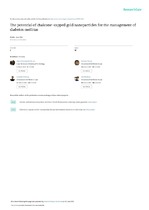The potential of chalcone-capped gold nanoparticles for the management of diabetes mellitus
Date
2021-08Author
Pearce, Brendon
Benjeddou, Mongi
Botha, Subelia
Omolaja, Akinfenwa, A
Omuruyia, Sylvester, I
Badmus, Jelili, A
Ismail, Enas
Marnewick, Jeanine
Ekpob, Okobi, E
Hussein, Ahmed, A
Metadata
Show full item recordAbstract
Searching for new natural bioactive capping agents represent an urgent priority in the green synthesis of metal nanoparticles. Additionaly, the biosaftey of metal nanparticles is a major concern especially in medical applications. Recently, the use of pharmacollogicaly active natural products as capping agents has been deployed to avoid toxic effects during the nanoparticles preparation and to enhance their drugability compared with convential drugs. Helichrysum foetidum is a South African medicinal plant used in folk medicine for the treatment of different human pathologies, and it is known to contain a variety of bioactive compounds. Herein, the total extract and two pure chalcones, helichrysetin and helichrysin, isolated from the same plant were successfully used to synthesize quasi-monodispersed gold nanoparticles in the size range of 2–12 nm. The bio-evaluation of samples indicated that the AuNP/capping agent conjugates are biostable, and have different biological profiles from the total extract/pure compounds. The enzymatic inhibition assays showed significant inhibition by the total extract, helichrysetin and their gold nanoparticles. Interestingly, a similar activity was observed for glucose uptake in HEK293 treated cells. On the other hand, all the tested samples relatively demonstrated no cytotoxicity when tested against the HaCaT keratinocytes. In conclusion, the study demonstrated potential enhancement of glucose uptake in mammalian kidney cells, and inhibition of carbohydrate-hydrolysing enzymes by green synthesized gold nanoparticles of H. foetidum. It also provides a therapeutic appraisal of AuNPs/chalcones conjugate towards the development of antidiabetes drugs derived from H. foetidum and its gold nanoparticles.

